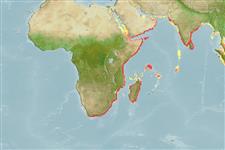>
Eupercaria/misc (Various families in series Eupercaria) >
Haemulidae (Grunts) > Haemulinae
Etymology: Pomadasys: Greek, poma, -atos = cover, operculum + Greek, dasys = with hair (Ref. 45335).
More on author: Day.
Environment: milieu / climate zone / depth range / distribution range
นิเวศวิทยา
เกี่ยวกับทะเล,น้ำเค็ม; กร่อย เกี่ยวกับหินโสโครก; ระดับความลึก 1 - 50 m (Ref. 97537). Tropical; 26°N - 35°S, 14°E - 101°E
Southeast Atlantic: north of Swakopmund, Namibia (Ref. 11228). Indian Ocean: east coast of Africa and Madagascar to Arabia, India and the Malay Peninsula.
Length at first maturity / ขนาด / น้ำหนัก / Age
Maturity: Lm 15.0 range ? - ? cm
Max length : 55.0 cm TL เพศผู้/กระเทย; (Ref. 2135)
เงี่ยงครีบหลัง (รวม): 12; ก้านครีบอ่อนที่หาง (รวม): 15-17; เงี่ยงครีบก้น 3; ก้านครีบอ่อนที่ก้น: 11 - 13. Silver to greenish, darker above; dark blotch on upper opercle; young with yellowish fins, older specimens dusky (Ref. 2799).
Inhabits coastal waters (Ref. 5213). Plentiful in tidal estuaries (Ref. 2135). Stomach contents of specimens collected from Iraq composed mainly of mollusks, sponges and tunicates (Ref. 97537). Large shoals of juveniles occur around shallow water reefs where they consume shrimps and other small invertebrates, being themselves eaten by larger fish; larger specimens are found in deeper water where they spawn throughout the year. Used extensively for bait, flesh rather insipid (Ref. 2799).
Life cycle and mating behavior
วัยเจริญพันธุ์ | การสืบพันธุ์ | การวางไข่ | เซลสืบพันธ์ของเพศเมีย(ไข่) | ความดกของไข่ | ตัวอ่อน
Oviparous, distinct pairing during breeding (Ref. 205).
Roux, C., 1986. Pomadasyidae. p. 327-330. In J. Daget, J.-P. Gosse and D.F.E. Thys van den Audenaerde (eds.) Check-list of the freshwater fishes of Africa (CLOFFA). ISNB, Brussels; MRAC, Tervuren; and ORSTOM, Paris. Vol. 2. (Ref. 2135)
IUCN Red List Status (Ref. 130435)
Threat to humans
Harmless
Human uses
การประมง: การค้า; เหยื่อ: usually
ข้อมูลเพิ่มเติม
อ้างอิงการเพาะเลี้ยงสัตว์น้ำประวัติการเพาะเลี้ยงสัตว์น้ำสายพันธุ์พันธุศาสตร์ElectrophoresesอัตราพันธุกรรมโรคการแปรรูปNutrientsMass conversion
ผู้ร่วมมือรูปภาพหลายรูปStamps, Coins Misc.เสียงปลามีพิษ เช่น ปลาปักเป้าความเร็วรูปแบบการว่ายน้ำพื้นที่เหงือกOtolithsสมองวิสัยทัศน์
เครื่องมือ
Special reports
Download XML
แหล่งที่มาจากอินเตอร์เน็ต
Estimates based on models
Preferred temperature (Ref.
123201): 23.8 - 28.6, mean 27 °C (based on 176 cells).
Phylogenetic diversity index (Ref.
82804): PD
50 = 0.5000 [Uniqueness, from 0.5 = low to 2.0 = high].
Bayesian length-weight: a=0.01479 (0.00745 - 0.02937), b=2.98 (2.82 - 3.14), in cm total length, based on LWR estimates for this species & Genus-body shape (Ref.
93245).
ระดับชั้นอาหาร (Ref.
69278): 2.6 ±0.14 se; based on food items.
ความสามารถในการกลับคืนสู่ปกติ (Ref.
120179): ขนาดกลาง, เวลาต่ำสุดที่จะทำให้ประชากรเพิ่มขึ้นเป็น 2 เท่าใช้เวลา 1.4 - 4.4 ปี (Preliminary K or Fecundity.).
Fishing Vulnerability (Ref.
59153): Moderate vulnerability (42 of 100).
Nutrients (Ref.
124155): Calcium = 33.1 [12.5, 69.1] mg/100g; Iron = 0.554 [0.283, 0.974] mg/100g; Protein = 19.2 [17.3, 21.0] %; Omega3 = 0.122 [0.065, 0.205] g/100g; Selenium = 34.7 [19.0, 62.9] μg/100g; VitaminA = 57.7 [19.7, 167.1] μg/100g; Zinc = 1.54 [1.05, 2.26] mg/100g (wet weight);
